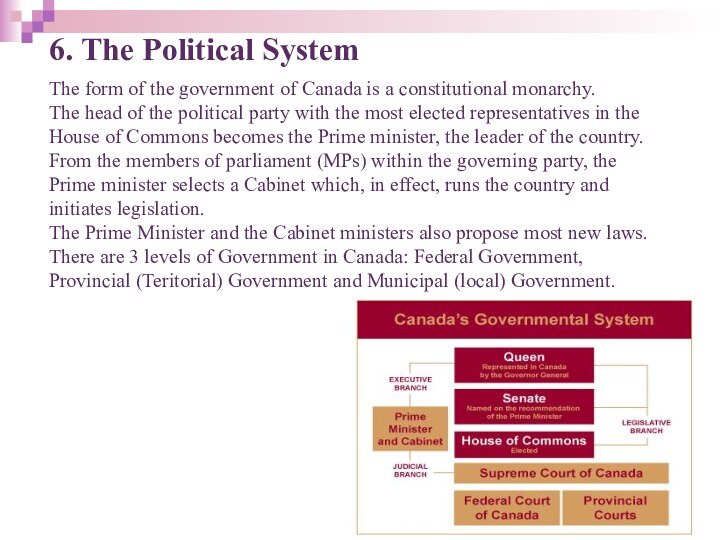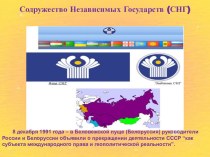Слайд 2
1. Physical and Geographical Features
Canada occupies the northern
third of North America. The land area its 10
million square kilometers. Canada is surrounded by oceans on three sides: the Atlantic on the east, the Pacific on the west and the Arctic on the north.
To the east is the narrow plain of the Great Lakes and the St. Lawrence; to the west - the rolling plains; to the center - the Hudson Bay Lowlands; and the north - the Arctic Lowlands. Together, these plains cover one quarter of the territory.
Two majestic river systems stand out: in the North - the Mackenzie, and in the east, - the St. Lawrence.
Слайд 3
2. Mineral Resources
The Canadian Shield, which forms the
stable care of the North American Continent, is composed
of the most ancient rocks on the planet.
These formations bear minerals such as iron, nickel, copper, zinc, uranium, magnesium and lead, gold, silver and platinum
Слайд 4
3. The weather
Canada is a cold country. During
the winter no place within its boundaries escapes the
bite of frost. On the other hand, its southern regions have hot or even scorching summers. In fact, this vast country is home to several climates: an arctic climate in the Far North, a relatively cold and wet climate in the east, a continental climate in the center, and a mild, wet climate on the West Coast.
The farther south - the less severe the winter chill.
Only a small region in southern Alberta enjoys a few episodes of respite during the winter, thanks to a warm, dry wind from the Pacific that sometimes manages to find its way there.
Слайд 5
4. The History
In 1535, when Jacques Cartier
reached the island known today as Montreal, he discovered
that it had «fine plough land». This was the land of the farming peoples who occupied the Great Lakes and St. Lawrence region at that time, living in villages of as many as 2000 inhabitants.
After a few decades in one place, when the soil was depleted, these peoples moved their villages and cleared new land.
Scattered bends of nomadic hunters lived on the wide belt of boreal forest and taiga that crosses Canada from Labrador to the Yukon, as in the forest of what are now the Atlantic Provinces.
When the good weather arrived, they gathered at water’s edge to fish, hunt for birds, collect eggs and gather roots and berries. The forest also supplied them with a precious material: birch bark. This was ideal for making various containers, wigwams and the indispensable canoes.
Слайд 6
For their part, the nomads of the western
plains truly worshipped the buffalo, for that animal provided
them with everything they needed in order to live - with the exception, they said, of water to slake their thirst and roles to constrict their teepees.
The life of buffalo hunters improved substantially when the horse, introduced by the Spanish in the 16-th century made its appearance on the northern plains in the 18-th century. The nomads could then move about more quickly and carry more with them.
Слайд 7
On the Pacific Coast, Aboriginal peoples enjoyed the
bounty of nature. The greatest of all natures riches
was the abundance of salmon. For the Aboriginal peoples, salmon were nothing less than reincarnated human being who would continue to offer themselves to the fishermen so long as the fishermen returned their bones to the sea.
The seacoast of this region provided its human inhabitants with a profusion of fish, sea mammals, water birds, edible seaweed and shellfish. Its forests abounded in priceless resources: wood to build villages and carve boats or totem poles; goafs wool for weaving; and a wide variety of meat, berries roots and mushrooms to vary the diet.
The Inuit of the Arctic occupied vast icy expanses that offered no protection against the elements, no edible vegetation and no building materials. Yet the Inuit managed to survive in this hostile environment and create a unique culture that assigns a central role to art.
Слайд 8
The first Europeans arrived from the northeast. They
were Vickings, who reached the coast of Newfoundland in
the 10-th century by travelling from southern Greenland. Other Europeans did not reach the continent until six centuries later, when navigation techniques and instruments had improved. This time, their presence was more lasting.
The West Coast had attracted Europeans for its furs beginning in the late 18-th century. After a territorial dispute with the Spanish, the British established the sister colonies of Vancouver Island and British Columbia. Gold seekers began to invade this little-frequented region in 1858, marking the start of a more sustained European presence. A few decades later, the construction of the railroad accelerated European settlement.
Immigrants engaged in a variety of economic activities, including the forest industry, salmon canneries on the coasts, mines in the Kootenay region and fruit growing in the Okanagan Valley.
Слайд 9
In Canada, industrialization began in the second half
of the 19-th century. Many factories using steam power
made their appearance at that time, including flourmills, sawmills shoe factories, textile plants, foundries and factories manufacturing transportation equipment. Industrial progress intensified in the early 20-th century with the introduction of electricity. New industries sprang up, especially in the fields of electrical equipment, chemicals, the automobile, aluminum, pulp and paper, radio and household appliances. Following the Second World War, industrialization entered a truly expansionist spiral, giving rise to a consumer society.
By 1870, Montreal and Toronto were the growth centers of Canada’s commercial, industrial and financial activity. As the Canadian economy turned toward industries and then services, the population movement toward the cities gathered strength.
Слайд 10
5. Population and Main Cities
Most of Canada’s population
of 30,6 million lived within 200 kilometres of the
United States. Thousands of kilometres to the North, the Polar Region - the Yukon, the Northwest Territories and Nunavut - is relatively empty, embracing 41% of Canadian land mass but only 0.3% of Canada’s population.
Some of the metropolitan areas have watched the tide turn on population growth. The majority of Canadians - 6 out of every 10 - lived in Ontario and Quebec. Canada’s North has a young population.
Main (the largest) cities of Canada are Toronto, Montreal, Vancouver.
Ottawa is the capital city of Canada.
Слайд 11
6. The Political System
The form of the government
of Canada is a constitutional monarchy.
The head of the
political party with the most elected representatives in the House of Commons becomes the Prime minister, the leader of the country. From the members of parliament (MPs) within the governing party, the Prime minister selects a Cabinet which, in effect, runs the country and initiates legislation.
The Prime Minister and the Cabinet ministers also propose most new laws.
There are 3 levels of Government in Canada: Federal Government, Provincial (Teritorial) Government and Municipal (local) Government.









































